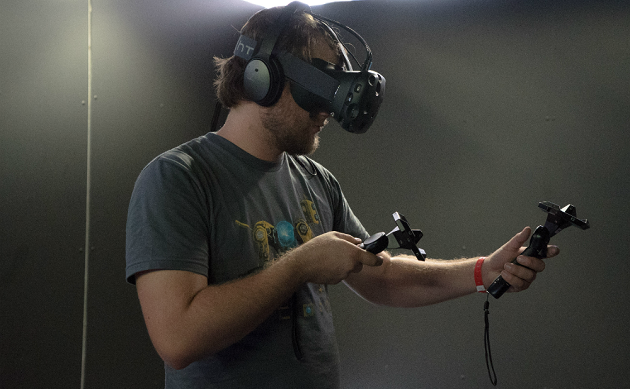You don’t have an HTC Vive right now. You were anticipating that you would do. That’s the promise both HTC and Valve made all the way back in March when it first revealed one of the most anticipated virtual reality (VR) head-mounted displays (HMDs) on the horizon. Sadly, there are still another four months to wait; the HTC Vive is now expected to arrive until April 2016. HTC, however, insists that there’s a very good reason for this delay: a ‘very, very big breakthrough’ that lead the company to revise the first edition of the device.
Just what this apparent revolution could be remains unclear, though it should be revealed in a matter of weeks as the company takes the HTC Vive to the 2016 Consumer Electronics Show from 6th – 9th January. For now, all we can do is guess, though we do at least have some hints to help us along the way.
Last week supposed images of the new HTC Vive leaked online, including one shot of the new HMD and one shot of the new position tracked controllers. The HMD itself looks largely similar to the older one, though does contain one pivotal new feature; a front-mounted camera that rests in the middle of the bottom of the device. Assuming these images are the real deal, this could have a number of uses, the most obvious being a pass-through device to see into the real world much like with what’s already possible on Gear VR. That’s hardly a ‘very, very big breakthrough’, however.
It could be, then, that the camera boasts some more elaborate features such as hand-tracking. That said, this seems unlikely given that there’s not much use for such a system when position-tracked controllers are a key feature of the device. It’s true that not all experiences on the HTC Vive will be using the SteamVR controllers, but a wide array do and the ones that don’t won’t necessarily need this feature either. Hand-tracking will likely play a big role in VR’s future, but it doesn’t seem like an essential, major addition to a kit that already supports and promotes a similar form of input, especially with such a short time before release.
Crucially, this sounds like a breakthrough on HTC’s side rather than Valve’s SteamVR system. So, while we’d like to think this could be an expansion of the limits of Room Scale user-tracking or an update to its capabilities, this doesn’t seem like the likely option, either.
When you look at the limitations of current VR, there are some areas that are obviously in need of the kind of breakthroughs that HTC is teasing. PC-based devices, for example, must be tethered to a rig in order to run. If HTC had found a way to circumvent this and deliver a wireless device, it would certainly be one of the biggest advances for the tech yet. This is definitely something that would be worth delaying the device for, but still seems like such a far off concept that it’s difficult to imagine that HTC has pulled it off in the here and now.
There are plenty of other features the company could have improved. It might have updated its display resolution to further combat the dreaded screen door effect, or improved the battery life of its controllers. With the kit launching in the near future, it feels like advances such as this are more likely, as they wouldn’t impact development of titles that are either finished or nearing completion.
Whatever the breakthrough is, all eyes are on the HTC Vive to make the first big VR story of 2016. VRFocus will be at CES itself to bring you the latest coverage of the kit and all others.
-END-
The post VR vs. HTC Vive’s ‘big breakthrough: Just What is the Big Surprise? appeared first on VRFocus.
















